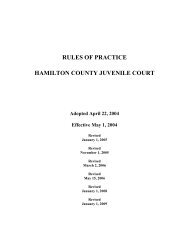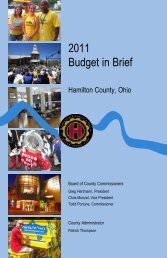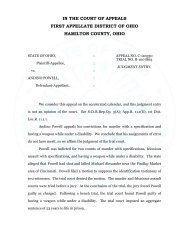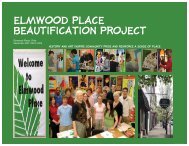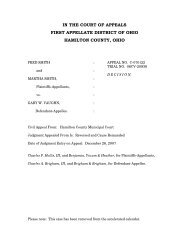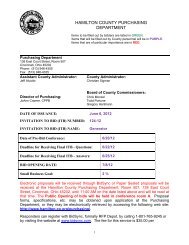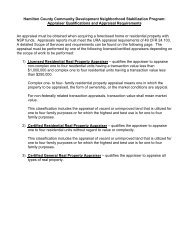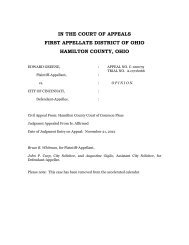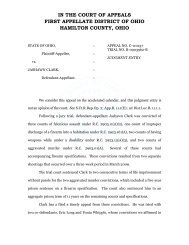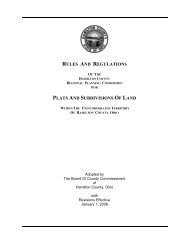Planning Commissioners' Procedures Manual - Hamilton County, Ohio
Planning Commissioners' Procedures Manual - Hamilton County, Ohio
Planning Commissioners' Procedures Manual - Hamilton County, Ohio
You also want an ePaper? Increase the reach of your titles
YUMPU automatically turns print PDFs into web optimized ePapers that Google loves.
evidence of an anticipated gross income of $2,500. Removing land from an agricultural district<br />
before the five year agreement will incur a recoupment penalty of 25% of the assessed value.<br />
All or part of the land may be enrolled as an agriculture district. The district will continue for<br />
five years and then the owner can reapply for continuance of the district. There are other<br />
conditions concerning removal, annexation, and defferments in the <strong>Ohio</strong> Revised Code (929) that<br />
should be reviewed by planners, elected officials, and landowners.<br />
Residential Districts<br />
Residential districts may be established in several categories depending on the type of<br />
development already established or anticipated. Factors that must be considered are:<br />
• density of population<br />
• existing and proposed streets and utilities<br />
• variety of housing types (single family dwellings, multi family units, mobile home parks)<br />
• variety of housing price groupings<br />
The use of Cluster Development/Planned Unit Development and conditional uses are some<br />
methods that provide flexibility in zoning regulations. Distinctions in use are identified in zoning<br />
by use of density codes.<br />
Business Districts<br />
Land zoned for commercial use should be based on need for the establishments and not just on<br />
proximity to major thorough fares. Too often strip commercial development is permitted by<br />
zoning excessively large road frontages for commercial use. Service streets, performance<br />
standards, and conditional uses are part of the development planning.<br />
Industrial Districts<br />
Industrial districts may or may not be needed depending upon the location of the area to be<br />
zoned and its present mix of land uses. Areas properly zoned for industry is an additional<br />
incentive for industrial expansions well as new industry because the community indicates 1) it<br />
wants to protect its industry from possible nuisance suits from incompatible uses that could be<br />
established too near to the district and 2) it is providing "protected" land for future growth. Too<br />
often, more land than necessary is zoned for industrial use. Flexibility can be build into this type<br />
of zoning district by the use of performance standards for compatibility with non-industrial<br />
neighboring areas.<br />
Within these districts or as a separate district, other uses or non-uses may be addressed. Parks<br />
and open space for non-designated recreation use. Flood plains may be zoned as restricted or<br />
non-use areas.<br />
To best accomplish compatible uses, a comprehensive plan should be used as a guide.<br />
Compatible uses within districts and in adjacent districts do not "just happen". Planners and



